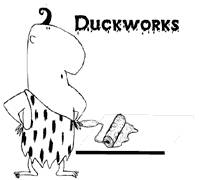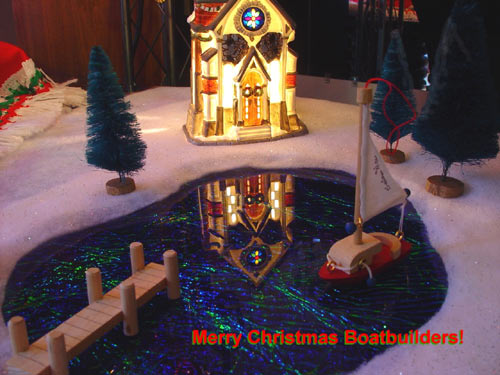| Hi Chuck,
It's so tempting to reach for the tools and start cutting out a boat
after reading the articles in Duckworks. However, I must try and
stay focused on the home kitchen project for now. Maybe something will
need an epoxy fillet along the way. Thankfully, DUCKWORKS will provide a
temporary peace within my yearning soul.- VERY NICE canoe by the way!
To show my continued appreciation, I would like to offer a painting tip to
all the lucky one's building something that floats. It's is a simple
"roller painting" trick that we use here in the sign shop. With a few
minutes of practice, the results can provide a painted "sprayed look" on
smooth panels without actually spraying. We are typically roller painting
sign panels, but a nice boat hull or some console panels certainly would
warrant a beautiful finish too. We work mostly with the heavier bodied oil
or latex based paints here at the shop, so I've never tried this method
with a polyurethane boat paint. If I get a chance I'll try it and send in
the results.
Here are my steps:
First, we prepare a typical paint roller cage by drilling a small
hole through the plastic collar piece located nearest the handle/cage
shaft entry point. The hole location is not that important, but, the hole
diameter should be just large enough to insert a 3"or 4" common nail into
the collar piece without a struggle. Basically, we want the nail, when in
the hole, to extend just enough to bind the cage and keep the roller pad
from revolving.
As always, before painting, make sure the panel has been properly cleaned
and tacked off. Also, we usually run our paint through a paint strainer
before each use.
Next, without the nail inserted, we paint the panel in the normal "free
spinning" roller fashion. We want good surface paint coverage without any
dust or debris mixed in. Don't worry about how smooth the finish is yet,
just get the paint even. No thin spots. Now, insert the nail into the
collar hole and bind the same "paint wet" roller pad against the roller
shaft. We want to complete the next step while the paint still flows
nicely on the panel surface. If the paint becomes tacky this trick won't
work.
 Holding the roller and
extending an arm out as far as is comfortable, place the roller onto the
newly painted panel surface. You could use a short roller extension handle
here to gain some "reach" for a long panel. Now, gently pull back using
just the weight of the gliding roller back towards you. At the end of your
backstroke, gently lift it off the surface. Do not apply any downward
pressure while pulling back. As we pull the roller straight back, the
still "paint wet" roller pad, will level and smooth the newly painted
surface. Holding the roller and
extending an arm out as far as is comfortable, place the roller onto the
newly painted panel surface. You could use a short roller extension handle
here to gain some "reach" for a long panel. Now, gently pull back using
just the weight of the gliding roller back towards you. At the end of your
backstroke, gently lift it off the surface. Do not apply any downward
pressure while pulling back. As we pull the roller straight back, the
still "paint wet" roller pad, will level and smooth the newly painted
surface.
Overlap each backstroke by a few inches with the roller pad and
repeat the process pulling in the same direction until the entire surface
is like glass. Give it a few tries and you'll have it right. If you need a
2nd coat use the same method. If we feel really fussy, we might paint the
primer coats like this sometimes too.
We like the 9" gray foam rollers, but have used the short nap with
equal success. If you want to take a long break or re-coat the next day,
try this to save the roller pad. Seal the paint roller pad, still fresh
with paint, tightly in Clear Plastic Wrap and put it in a cool place. The
roller pads will keep quite a while if stored this way. I do it rather
than waste a roller pad on a quick job or between coats. I've heard that
some shops might keep a little "Cold Beer" refrig, (mine?, no way!, never!
) which if true, would work as the cool place for a roller cover. Not the
one with the guys use for the lunch pails though !
I hope this tip was helpful! Take Care,
Phil Aldo
|
Hi Chuck,
Since your magazine has me addicted to boatbuilding (all your fault) I
thought I'd send this pic for you and the other addicts. It's a neat
story, that started from my grandmother. When I was little, she used to
make a miniature village scene with a lake by taking the cotton "snow"
material and cutting open an oval shaped hole in it that she put a hand
mirror underneath, where I would then place figurines of skaters and build
a village around with miniature houses, cars, sleighs etc.

Then, a few days ago, (fast forward thirty years) my wife was
setting up the Christmas tree on one of my Dichrolam tables (laminated
glass I make, that looks like water) and was thinking about doing the same
thing that my grandmother did. Then Tricia pulls out this little wooden
boat ornament I had never seen! So I quickly made a miniature "dock" and
set up the "lake" scene. Very appropriate since I'm knee deep in the
middle of my second glass-bottomed boat. See the progress at:
www.pbase.com/dr_dichro
and click on New Boat Construction.
www.Pbase.com is a wonderful site to upload pics into your own
gallery for free.
Merry Christmas,
John Blazy
|
The following appeared in
Messing About in Boats
magazine
We have received a ten part series of "Occasional Ramblings from a
Small Craft Designer" from New Zealander John Welsford which will run
well into summer, and have promise of a supplementary series of his
specific designs for you to look over. Our November 15 issue carried a
bit of a preview of the latter in John's presentation of his design
"Tread Lightly".
John's perspective on small boat design includes more than just the
technical details of designing a boat, as he says in this issue's
introductory "From the Drawing Board, "I not only discuss the boat's
capabilities and strengths, where and how it is intended to be used, the
loads it will carry and how far, but also the smell of the salt and the
skirl of the gulls overhead, the spray flying as she butts through the
rising chop and the warmth from the stove when at last she is at anchor
in some remote sheltered cove." You gotta like this approach.
Occasionally we'd hear from someone grumbling about why so much Bolger
and so little from any other designers? My answer to that was easy,
"Phil sends us his stuff." Those "others" do not trouble to do so,
apparently not regarding the opportunity to let you know about their
work as being promising enough to warrant the effort to supply articles
about it. Now at last we have a new series from a designer of just the
sort of small boats we love, one well written with broader perspectives
on what this small boating is all about. This came about through the
good offices of Chuck Leinweber, publisher (if that's the correct term)
of the small boat "online magazine" Duckworks. I suspect many of you who
are internet fans are well aware of Chuck's efforts in this alternative
form of publishing. If not, have a look at his ad somewhere in this
issue.
Chuck has hooked up with John as his US agent and so it is naturally in
his best interest to get John's work out before all possible interested
persons, including those beyond his internet reach (there are a number
of us benighted Luddites despite the assumptions of internetters) and so
he's set us up to carry John's writings. Chuck and I have set up a
working arrangement for our mutual benefit. On our part we are
publishing the Weisford series and Chuck's advertisi ng
for Duckworks, while he is publishing advertising for us online for
those who might wish to see what we have to offer. He is even signing on
subscril)ers for us tlirough his credit card arrangement for doing-such
things online. I don't do credit cards for the same reason I don't do a
lot of. other of today's hi zoot things, it complicates my life more
than I care to have it complicated. ng
for Duckworks, while he is publishing advertising for us online for
those who might wish to see what we have to offer. He is even signing on
subscril)ers for us tlirough his credit card arrangement for doing-such
things online. I don't do credit cards for the same reason I don't do a
lot of. other of today's hi zoot things, it complicates my life more
than I care to have it complicated.
Bob Hicks
|